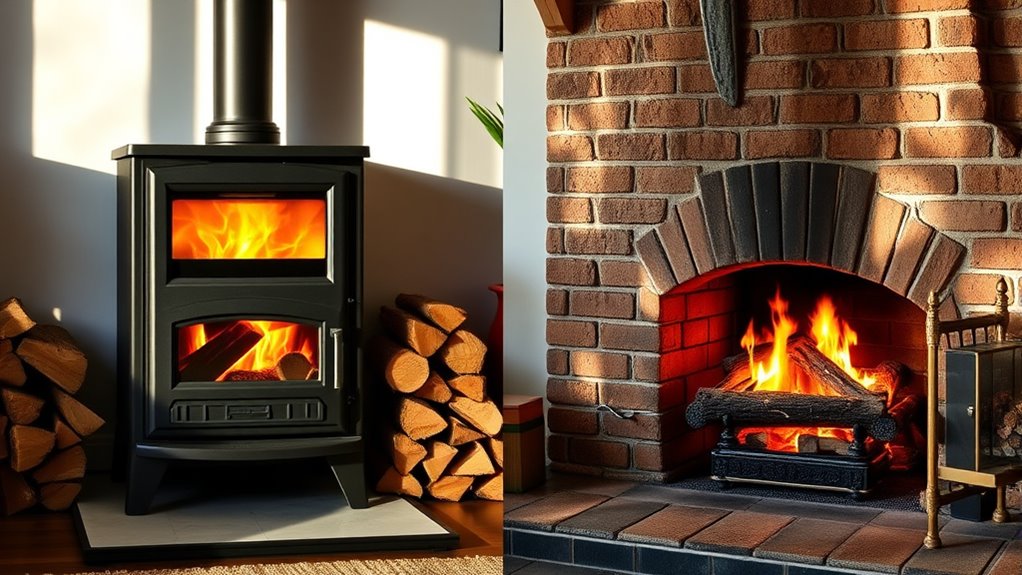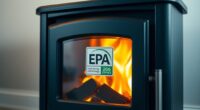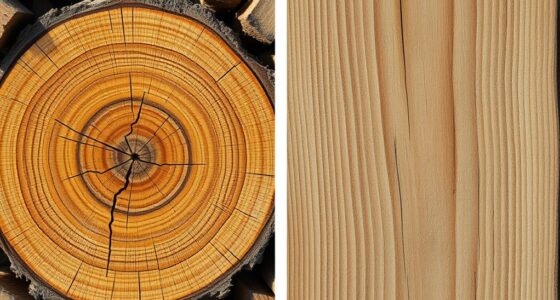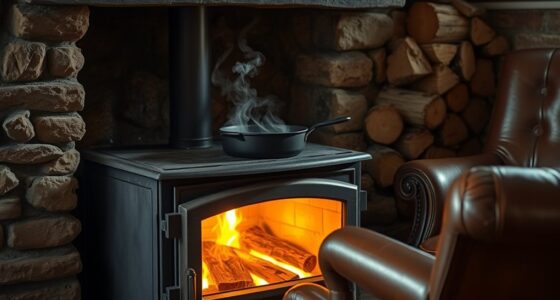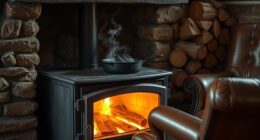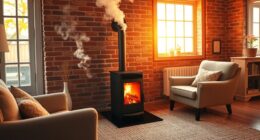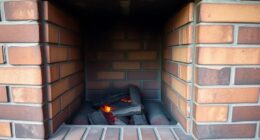Wood stoves are generally more efficient than traditional fireplaces because they burn wood more completely, converting up to 80% of fuel into heat, while fireplaces only reach 20-30% efficiency. They also distribute heat more evenly and use less fuel, saving you money and reducing emissions. If you want to know how these options compare for your home’s comfort and costs, explore further for detailed insights.
Key Takeaways
- Wood stoves typically achieve higher efficiency ratings, converting up to 80% of fuel into usable heat, compared to fireplaces’ 20-30%.
- Stoves contain enclosed fireboxes with controlled combustion, resulting in more complete burning and less wasted fuel.
- Fireplaces mainly radiate heat outward with limited air circulation, making them less efficient for overall space heating.
- Proper fuel seasoning and advanced stove technology enhance efficiency by maximizing heat output and reducing emissions.
- Regular maintenance and proper ventilation improve efficiency and safety for both fireplaces and wood stoves.
How Do Wood Stoves and Fireplaces Generate Heat?
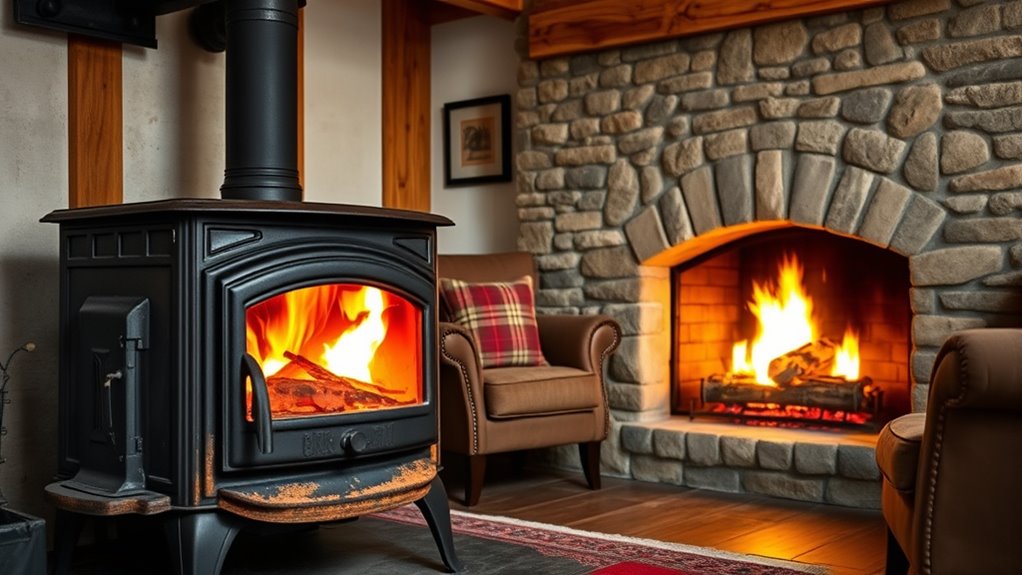
Wood stoves and fireplaces generate heat primarily by burning wood to produce combustion. When you light a fire, the wood releases energy as it burns, creating heat and light. In a traditional fireplace, the heat mostly escapes through the chimney, with only some warming the room directly from the flames and hot air rising. Wood stoves, on the other hand, are designed to contain the fire more efficiently. They use a closed firebox with a chimney or vent that directs heat into your living space. The combustion process heats the metal body of the stove, which then radiates warmth outward. Both methods depend on burning wood, but their designs impact how effectively they transfer heat to your home. Additionally, innovations in automation technologies have led to more efficient and safer heating methods in modern wood heating appliances. Proper insulation and heat retention also play a significant role in maximizing the efficiency of these heating methods, ensuring less heat escapes and more warmth stays within your home. Incorporating advanced burner designs can further improve combustion efficiency and reduce emissions. Using properly seasoned wood can also significantly enhance heat output and reduce creosote buildup in the chimney.
Efficiency Ratings and What They Mean
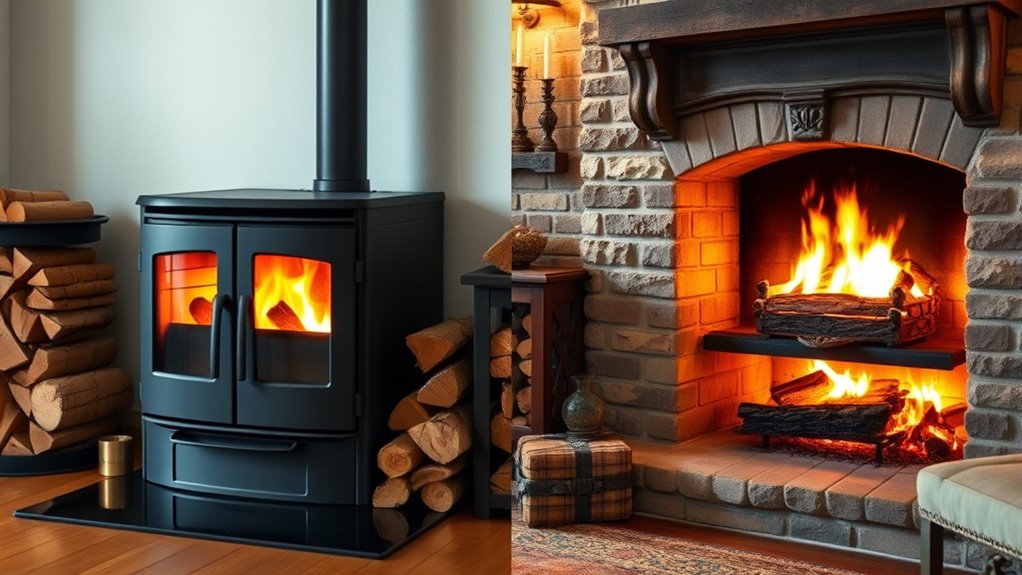
Efficiency ratings provide a clear way to compare how well different heating appliances convert wood into usable warmth. These ratings reflect how much heat from the wood actually heats your space, rather than just burning the fuel. A higher efficiency means less wood is wasted, saving you money and reducing emissions. Keep in mind: AI-generated music influences traditional music creation processes, affecting how sound design and acoustics are approached in the industry. – The EPA efficiency rating measures how cleanly and efficiently a stove burns. – Input vs. output efficiency shows how much of the wood’s energy is converted into heat. – Ratings can vary based on installation, usage, and maintenance, affecting real-world performance. Understanding these ratings helps you choose the most effective heating option for your home, ensuring you get the most warmth with the least waste.
Heat Output and Distribution in Different Spaces
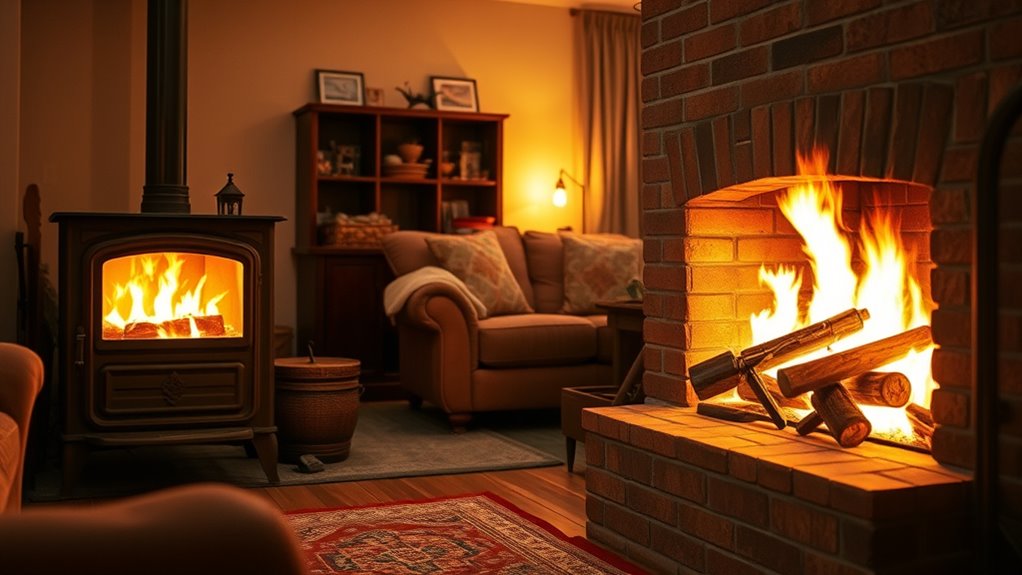
You’ll notice that heat spread patterns vary between wood stoves and fireplaces, affecting how evenly a space warms. Room size plays a big role in what system works best, since a small room may heat differently than a large one. Good airflow and circulation help maximize heat distribution, ensuring your space stays comfortable.
Heat Spread Patterns
While both wood stoves and fireplaces serve as focal points in a room, their heat spread patterns differ considerably. A fireplace mainly radiates heat outward and upward, creating a cozy glow but limited air circulation. In contrast, a wood stove distributes heat more evenly throughout the space, thanks to its enclosed design and blower options. Additionally, using Glycolic Acid in skincare routines can help improve skin texture, which is important for overall comfort in your living space. You’ll notice that: – Fireplaces generate localized warmth with strong direct radiation. – Wood stoves circulate warm air more effectively, reaching every corner. – Stoves often have fans to enhance heat distribution, making the space feel warmer faster. Incorporating professional heating advice can optimize your system’s efficiency and ensure proper heat distribution for your specific space. Understanding these patterns helps you choose the right heating method for your space, ensuring efficient and comfortable warmth where you need it most. Proper insulation also plays a vital role in maximizing heating efficiency in both setups. Additionally, heat output varies based on design and installation, influencing overall efficiency and comfort.
Room Size Compatibility
Choosing between a wood stove and a fireplace depends heavily on your room size and how much heat you need. A wood stove typically offers higher heat output, making it suitable for larger spaces. Fireplaces, on the other hand, are better for smaller rooms or open-concept areas where a cozy ambiance suffices. Consider the table below to match your space with the right heating option:
| Room Size | Recommended Option | Heat Distribution |
|---|---|---|
| Small | Fireplace | Localized heat |
| Medium | Fireplace or stove | Moderate spread |
| Large | Wood stove | Wide coverage |
| Open Plan | Wood stove | Consistent warmth |
Matching your room size with the right heating method guarantees efficiency and comfort. Additionally, selecting an appliance with appropriate heat output ensures effective heating tailored to your space.
Airflow and Circulation
Airflow and circulation play a crucial role in how effectively a wood stove or fireplace distributes heat throughout your space. Proper airflow ensures warm air reaches every corner, preventing cold spots and maximizing comfort. With a wood stove, heat is usually contained and radiates outward, so good circulation relies on natural convection or fans. Fireplaces, especially open ones, can create uneven heat distribution due to rapid heat loss up the chimney. To improve circulation:
- Use fans or vents to direct warm air into different areas
- Keep furniture and curtains away from vents for better airflow
- Regularly clean vents and chimneys to maintain efficiency
- Understanding home security systems can help protect your heating appliances from theft or tampering. Additionally, incorporating ventilation techniques can further enhance overall heat distribution and energy efficiency. Proper airflow management is essential for maximizing heating performance and reducing energy waste, especially in remote hackathons where innovative solutions for energy efficiency are often developed. Optimizing air circulation can also prevent moisture buildup and improve indoor air quality, contributing to a healthier living environment.
Fuel Consumption and Cost Effectiveness
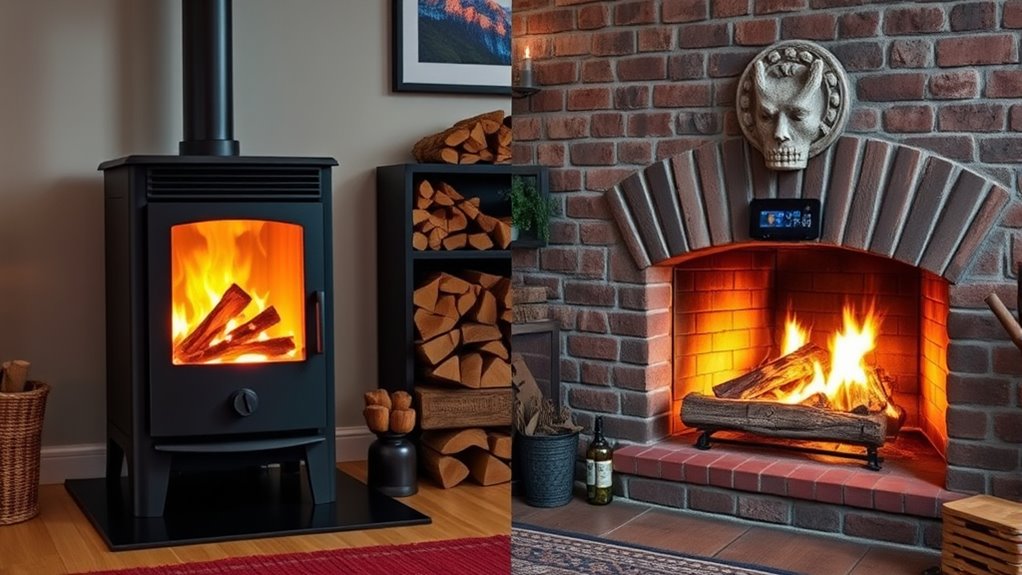
You’ll want to contemplate how different fuel types impact your overall costs and efficiency. Some options burn longer and cheaper, while others may save you money with better heating rates. Understanding these factors helps you choose the most cost-effective solution for your home. Additionally, considering the energy efficiency of each fuel type can further optimize your heating system’s performance and savings. Evaluating the fuel consumption rates can help you determine which option provides the best balance of cost and heat output over time.
Fuel Type Variability
How does the type of fuel impact the efficiency and overall cost of operating a wood stove or fireplace? Different fuels can markedly influence both performance and expenses. For example, seasoned hardwood burns longer and produces more heat than softwoods or unseasoned wood, reducing your fuel costs. Alternatively, using alternative fuels like compressed logs or pellets can provide cleaner burning and easier handling, but often at a higher price. Consider these factors:
- Fuel density: Denser fuels like hardwood last longer and generate more heat per load.
- Moisture content: Drier wood burns more efficiently, saving you money and reducing creosote buildup.
- Cost differences: Some fuels are cheaper but may burn less efficiently or produce more ash, impacting maintenance costs.
Choosing the right fuel maximizes heat output while minimizing costs, regardless of your heating appliance.
Heating Efficiency Rates
Fuel consumption directly influences the overall efficiency and cost-effectiveness of wood stoves and fireplaces. Wood stoves typically burn fuel more efficiently because they are designed for complete combustion, extracting more heat from each log. Fireplaces, on the other hand, often lose heat through the chimney and surrounding gaps, making them less efficient overall. You’ll find that stoves can convert up to 80% of fuel into usable heat, while traditional fireplaces may only reach 20-30%. This means you’ll need less wood and spend less money on fuel with a stove. When considering cost-effectiveness, a stove’s ability to produce more heat from less wood makes it a smarter choice in the long run. Efficient fuel use ultimately saves you money and keeps your home warmer.
Operational Expenses
Operational expenses for heating with wood stoves and fireplaces largely hinge on fuel consumption and overall cost efficiency. Your total costs depend on how much wood you burn and how effectively each option converts fuel into heat.
- Wood stoves tend to be more fuel-efficient, requiring less wood for the same heat output.
- Fireplaces often burn more wood, making them costlier over time.
- Maintenance and fuel costs influence your overall expenses, with stoves generally offering lower long-term costs.
Choosing the right option impacts your budget markedly. If you prioritize saving money, a well-maintained wood stove may be the better choice. Conversely, if aesthetic appeal matters more and fuel costs are manageable, a fireplace could work. Ultimately, understanding your fuel consumption and costs helps you make smarter decisions.
Environmental Impact and Emissions
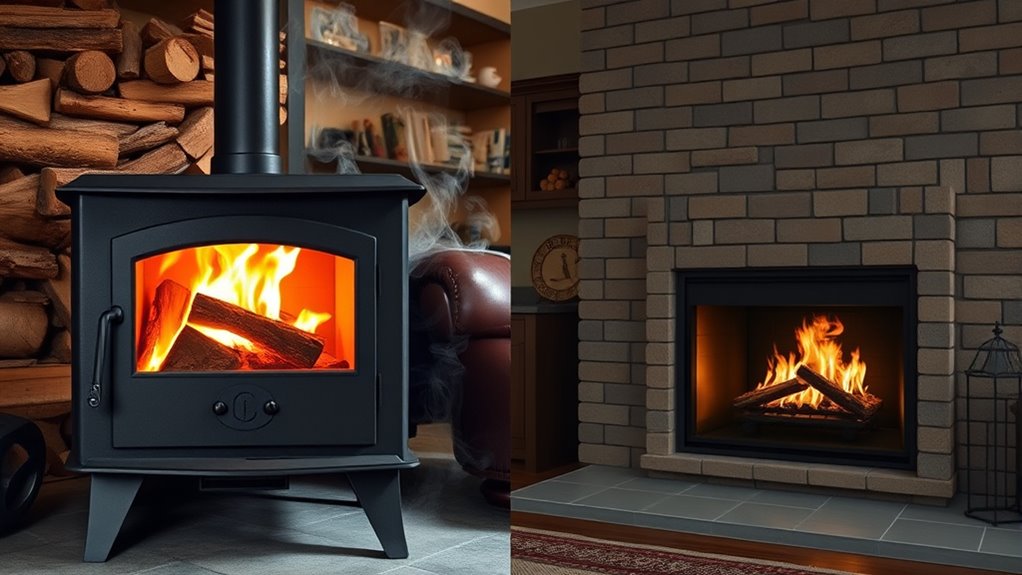
When comparing wood stoves and fireplaces, their environmental impacts and emissions play a crucial role in decision-making. Wood stoves generally burn wood more efficiently, producing fewer emissions and less smoke, which reduces air pollution. They are designed to maximize combustion, leading to cleaner burning and lower particulate matter released into the atmosphere. Fireplaces, especially traditional open hearths, tend to release more pollutants because they are less efficient and allow more smoke to escape into your living space and the environment. Additionally, wood stoves often meet stricter environmental standards, making them a more eco-friendly choice. However, both options still emit carbon dioxide and other pollutants, so your choice can considerably influence your household’s overall environmental footprint.
Safety Features and Considerations
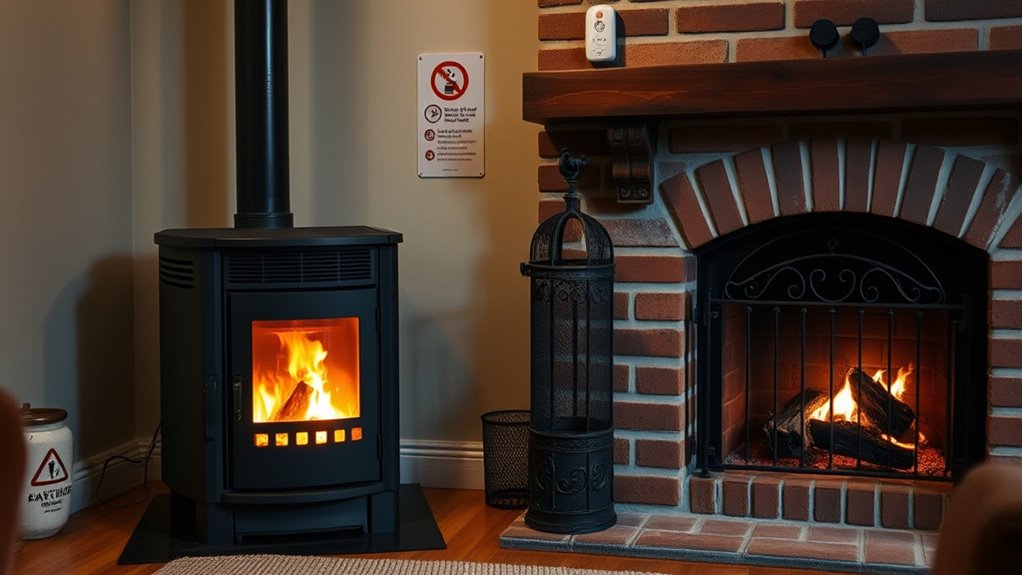
Ensuring safety when using a wood stove or fireplace is essential. You should regularly check fire safety mechanisms like smoke and carbon monoxide detectors, and follow proper ventilation practices to prevent dangerous buildup. Taking these precautions helps protect your home and loved ones from potential hazards.
Fire Safety Mechanisms
Fire safety mechanisms are indispensable to prevent accidents and protect your home when using a wood stove or fireplace. Installing safety devices helps reduce fire risks and ensures proper operation. For example, a smoke detector alerts you to smoke or fire early, giving you time to react. A carbon monoxide detector warns you of dangerous fumes that can accumulate if ventilation isn’t adequate. Additionally, installing a sturdy hearth gate or screen keeps sparks and embers contained, preventing burns or fires outside the stove or fireplace. Regularly inspecting and maintaining these safety features is crucial for reliable protection. Remember, safety mechanisms aren’t just devices—they’re your first line of defense in creating a secure environment when enjoying your heating source.
Proper Ventilation Practices
Proper ventilation is essential for safe and efficient operation of your wood stove or fireplace. It ensures harmful gases like carbon monoxide are safely vented outside, preventing dangerous buildup indoors. Always check that vents, chimneys, and flues are clear of obstructions and regularly maintained. Use proper damper controls to regulate airflow and prevent smoke from entering your home. Never block vents or restrict airflow, as this can cause inefficient burning and dangerous fumes. Installing carbon monoxide detectors near your stove or fireplace adds an extra safety layer. Ensure that your ventilation system complies with local building codes and manufacturer instructions. Regular inspections and maintenance keep your setup functioning safely, maximizing efficiency and protecting your household’s health.
Ease of Use and Maintenance Requirements
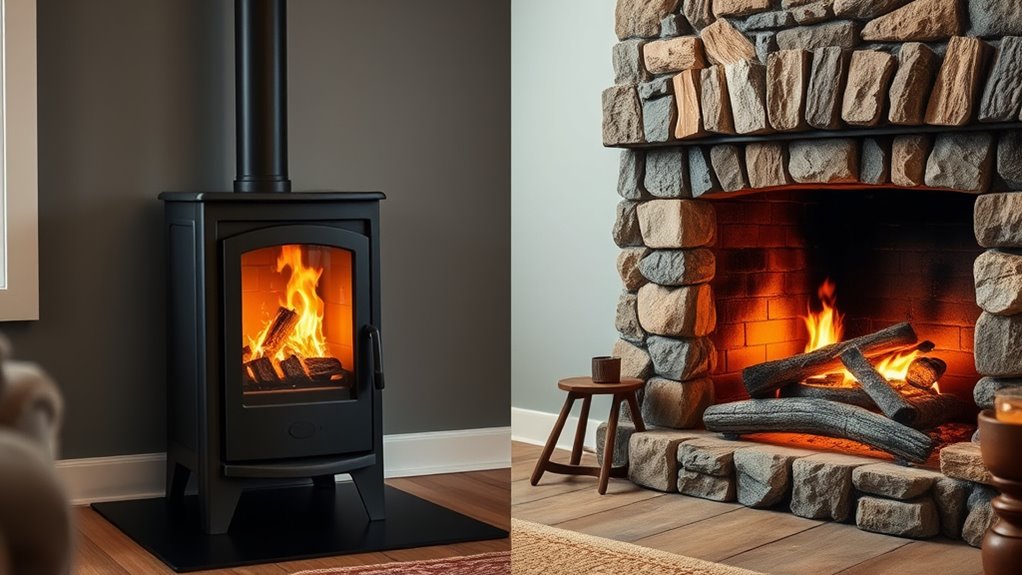
When comparing ease of use and maintenance, wood stoves generally require more effort to operate and keep in good condition than fireplaces. You’ll need to regularly load wood, monitor the fire, and manage ash buildup. They often demand more cleaning and maintenance to stay efficient. Fireplaces, on the other hand, tend to be simpler, mainly needing occasional chimney cleaning and ash removal.
Consider these points:
Wood stoves need frequent ash removal and daily tending for optimal performance.
- Wood stoves need frequent ash removal and filter checks
- They require daily tending to maintain proper airflow
- Fireplaces typically need less upkeep, mainly chimney cleaning and glass cleaning
Installation and Space Requirements

Installing a wood stove or fireplace involves different space and setup considerations that can impact your choice. A wood stove requires a sturdy, non-combustible surface and proper clearance around it for safety and airflow. You’ll also need a chimney pipe or venting system, which might require additional wall or roof penetration. In contrast, a traditional fireplace needs a chimney built into your home’s structure, often requiring significant masonry work or an existing chimney flue. Space-wise, fireplaces tend to take up more room and may limit furniture placement, while wood stoves are more compact and versatile in placement. Both options demand sufficient clearance for safety, but the installation complexity and space needs can influence your decision based on your available area and renovation plans.
Aesthetic Appeal and Ambiance Factors
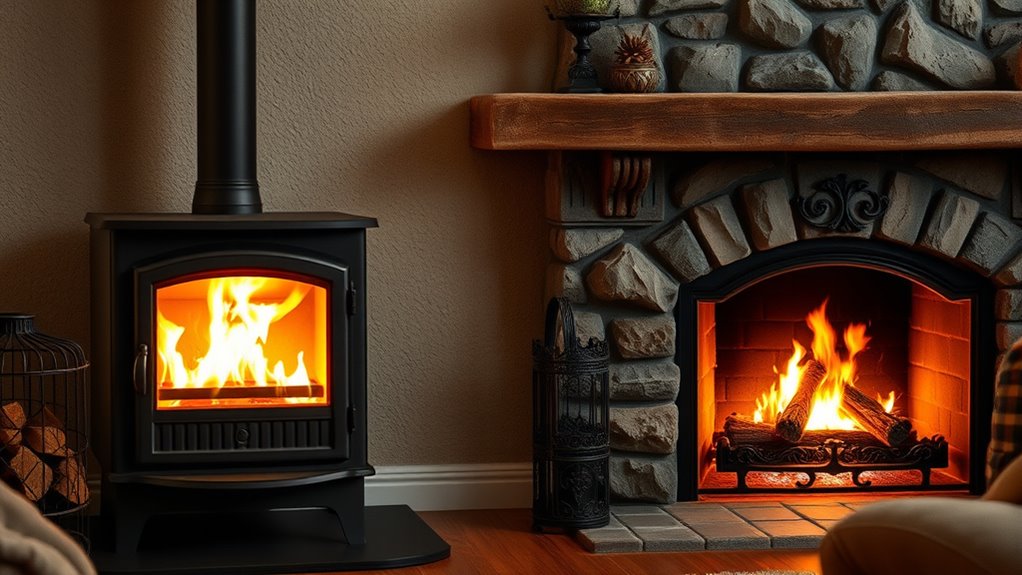
Both wood stoves and fireplaces serve as focal points that enhance your home’s visual appeal and create a cozy atmosphere, but they do so in different ways. A fireplace often features an open design, allowing you to see and enjoy the flames directly, adding warmth and charm to a room. In contrast, a wood stove has a more enclosed, efficient design that emphasizes a rustic, traditional look. Your choice impacts your home’s ambiance through:
- The visual impact of flickering flames
- The ability to customize the surround and mantel
- The overall style, from modern to classic
Fireplaces tend to create a more inviting, romantic setting, while wood stoves offer a practical, cozy aesthetic. Your preference depends on whether you prioritize visual drama or a warm, functional centerpiece.
Longevity and Durability of Heating Solutions
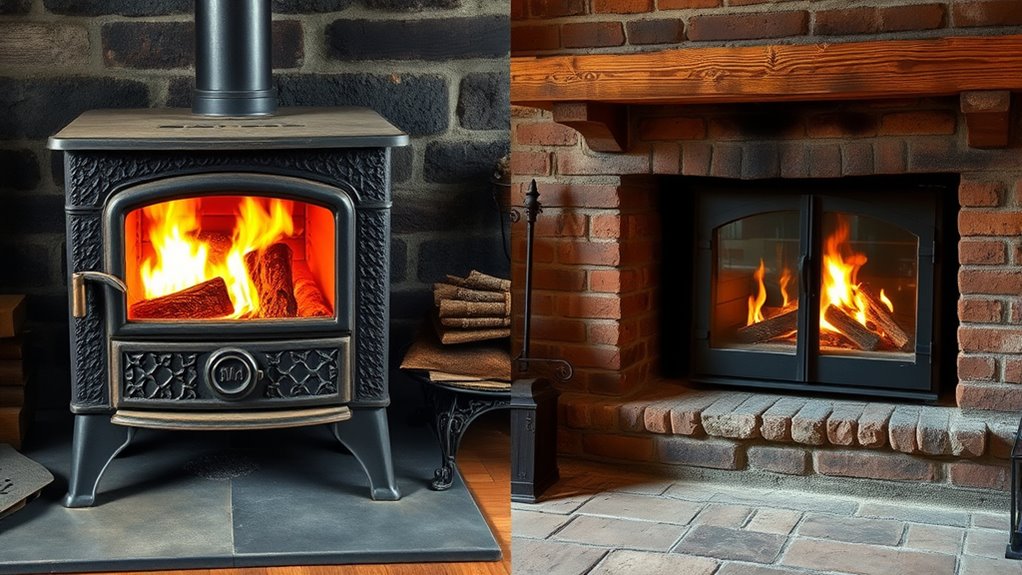
Choosing a durable heating solution means considering how well it will stand up over time to daily use and environmental factors. Wood stoves are typically built with heavy-duty steel or cast iron, making them resistant to warping and cracking. Fireplaces, especially brick or stone ones, can last decades if maintained properly but may crack or crumble with weather exposure.
| Material | Resistance | Maintenance Needed |
|---|---|---|
| Steel | High | Regular cleaning |
| Cast Iron | Very high | Rust prevention |
| Brick/Stone | Moderate | Tuckpointing, sealing |
Both options can last, but a wood stove’s metal construction generally offers better longevity with fewer repairs, while fireplaces require more upkeep but can also endure if well-maintained.
Frequently Asked Questions
Which Option Is Better for Large, Open-Plan Homes?
When heating large, open-plan homes, you need an option that provides consistent warmth and good coverage. A wood stove is often better because it heats efficiently and radiates heat evenly across big spaces. Fireplaces add charm but may not distribute heat as well. With a wood stove, you get better energy efficiency and more effective heating, making it the smarter choice for large, open areas.
How Do Heating Efficiencies Change Over Time?
Over time, heating efficiencies can decline due to wear and tear, buildup of creosote, or outdated technology. You might notice your stove or fireplace becoming less effective, requiring more fuel to produce the same heat. Regular maintenance, like cleaning and inspections, helps maintain efficiency. Upgrading to newer models can also improve performance, ensuring your heating system stays effective and energy-efficient as years pass.
Are Wood Stoves or Fireplaces More Energy-Efficient?
You want to know which option is more energy-efficient: a wood stove or a fireplace. Generally, wood stoves are more efficient because they burn wood more completely, producing more heat with less wood. Fireplaces often lose much of their heat through the chimney, making them less efficient. If you’re looking to maximize heat and minimize wood use, a wood stove is your better choice.
What Maintenance Issues Affect Long-Term Efficiency?
You should regularly clean and inspect your heating system to maintain long-term efficiency. For wood stoves and fireplaces, creosote buildup in chimneys can cause blockages and reduce heat transfer, so chimney cleaning is essential. Check door seals, gaskets, and vents for wear, as leaks lower efficiency. Additionally, verify proper airflow and remove ash buildup. Proper maintenance keeps your system running smoothly, saving energy and extending its lifespan.
Which Provides More Consistent Heat Distribution?
Imagine your home as a cozy cabin, where warmth should flow like a gentle river. A wood stove offers more consistent heat distribution, acting like a steady, reliable stream that reaches every corner. Unlike a fireplace, which can feel like flickering flames dancing unpredictably, a stove’s enclosed design guarantees your comfort is steady and uniform, spreading warmth evenly, so every room feels inviting and well-loved.
Conclusion
So, whether you prefer the old-world charm of a fireplace or the efficiency of a modern wood stove, remember—your choice might just be the reason your heating bills rise or fall. Ironically, what seems like a cozy upgrade could turn into a maintenance nightmare. In the end, it’s all about balancing style, cost, and convenience—because nothing says “warm and fuzzy” like realizing your heating decision might have been the most energy-consuming one yet.
